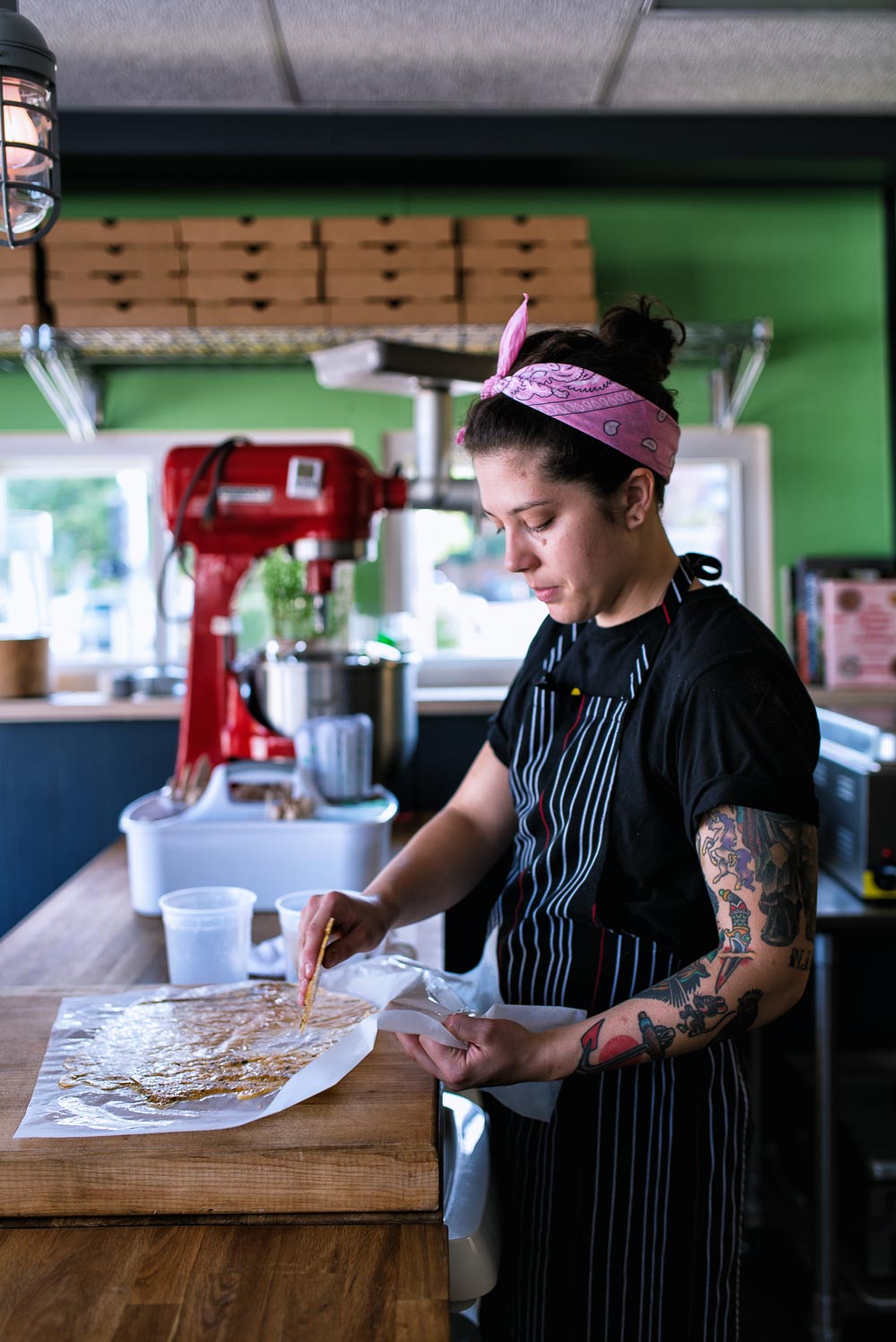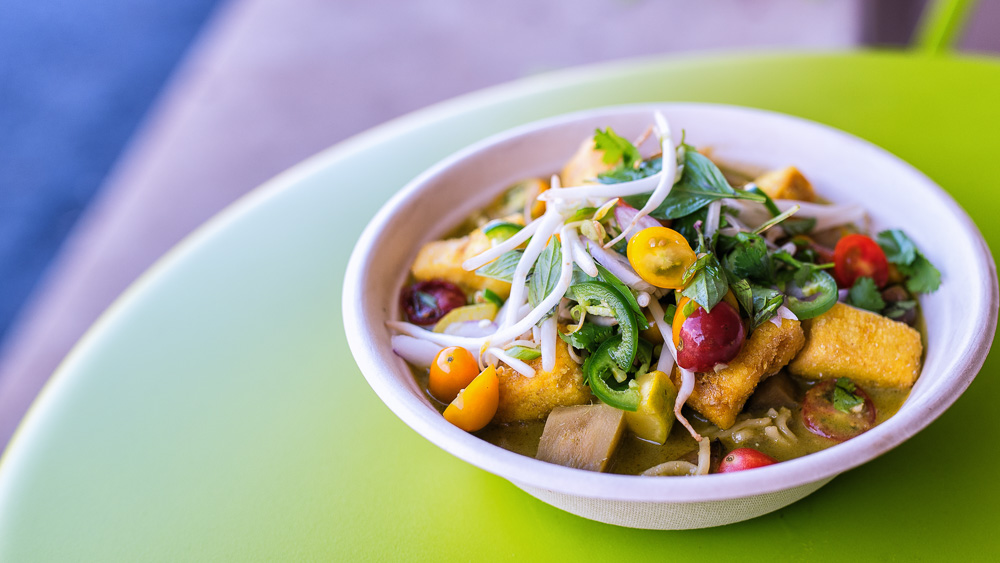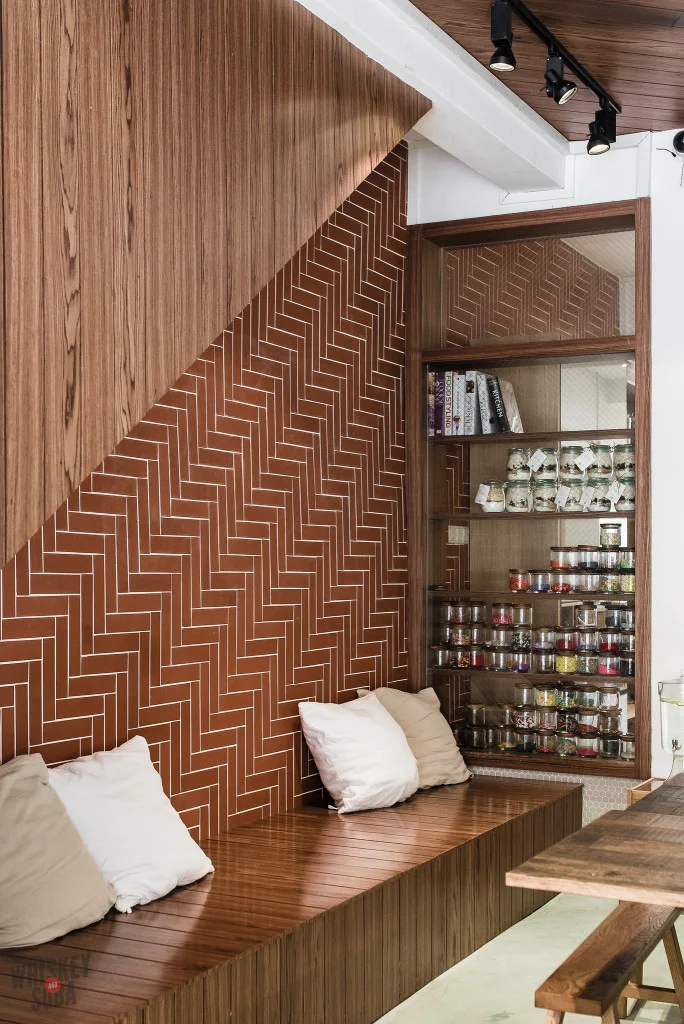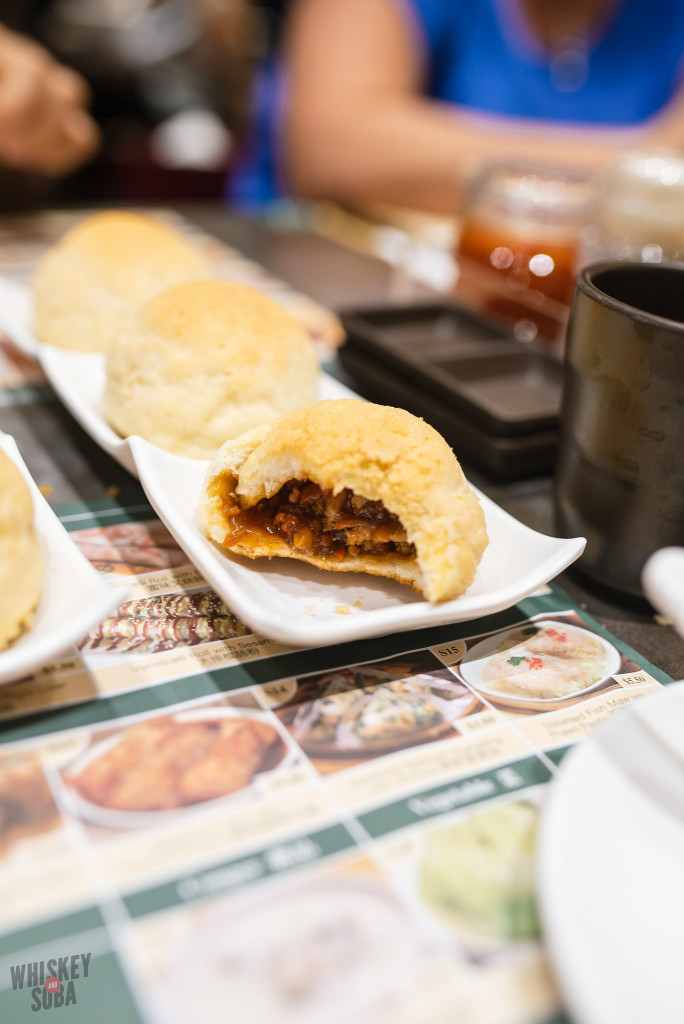Stuff to eat. Mostly around St. Louis.
Kitchen Kulture
I can't recall if it was last winter or the winter before it when I first encountered Kitchen Kulture, but I remember it like it was yesterday: I was at the Tower Grove Winter Farmers Market, contemplating if I should attempt to eat the Rebel Roots caramel apples I had just purchased on my drive home, when I turned and saw their booth. I'd followed them on social media and seen their Sump lunch menus, but I'd never managed to actually eat their food. I wandered over and perused the menu, when chef/co-owner Mike Miller and co-owner Chris Meyer offered me a sample of their Mofu Tofu Saag Paneer. I'm pretty sure my response was something along the lines of, "Why is this so good?" I sampled everything they had to offer and left with pounds and pounds of Kitchen Kulture food. Soba noodle salad, Khao Soi curry, vinaigrettes, whatever. If they were selling it, I was buying it. Weekly Kitchen Kulture purchases became part of my life.
Flash forward to summer of 2016, and Kitchen Kulture (the restaurant is known as Kounter Kulture) has moved into the former Pint Size Bakery shop off Watson. You can still find them at the weekly TG Farmers Market, of course, but the take-out only restaurant, open Monday-Friday, 4:30-9:30pm, offers a totally different menu of food cooked to order.
If I'm passionate about any type of food, it's Asian food—a cuisine that continues to disappoint here in St. Louis. I've tried to explain it before, but there's this whole wide world of Asian food, ingredients, flavors, cooking techniques, etc. that just aren't being tapped into here. Mike Miller gets it. Seriously, no other chef in St. Louis has been able to grasp modern Asian flavors—particularly Southeast Asian and Japanese—like he has. And he's doing it using locally sourced produce.
On the lighter end of the spectrum, there are dishes like the White Peach and Pepper salad with a creamy miso vinaigrette and crunch coming from a sesame-togarashi brittle that shatters like sugary glass. The seasonal greens spring rolls, packed with rice noodles, cilantro, mint, and mango, come with a carrot-ginger sauce, and remind me of a meal I had just outside of the Angkor Wat temple complex in Cambodia.
A Mofu tofu green curry with summer vegetables and ramen noodles gives Reeds American Table a run for their money as far as authentic curry goes—a pungent curry paste, made from scratch, mixed with coconut milk, fish sauce, and all those other funky Thai flavors delivers a Muay Thai elbow to your tongue.
On the heartier side of the menu, there's a Korean BBQ chicken rice bowl that makes your Chipotle burrito bowl look like it's child-sized. Crunchy, spicy, and sweet, the bulgogi chicken combined with heirloom tomatoes, fresh avocado, and a lime-cilantro dressing doesn't disappoint.
People typically generalize Japanese food as healthy, but believe me, the Japanese love fried food just as much—if not more—than Americans. They just don't eat buckets of it. The ping-pong ball-sized shrimp and pork gyoza tossed in tsume—a sweet, seafoody sauce—are perfect. The braised beef gyudon bowl is equally delicious.
I could write a book on my love of okonomiyaki. These Japanese pancakes are tied with takoyaki (basically grenades made of pancake dough and octopus) for my favorite Japanese food. Kounter Kulture's is kind of like if an okonomiyaki knocked up a Korean jeon pancake. Or maybe a frittata. Possibly a Dutch Baby? It's basically a puffed up egg-based pancake stuffed with your choice of kimchi, bacon, squid, and/or mushrooms, then topped with a sweet bbq sauce and mayo. It will feed you for days.
But their buns...their buns are out of this world. If Kounter Kulture only sold buns, I'd still tell you it's one of my favorite places in St. Louis. Do you go for the pork with smoked onions, chile-mustard sauce, and jalapeno slaw? Or the tofu bun with sesame cabbage, homemade kewpie mayo, and Japanese BBQ sauce? It doesn't matter, as long as you also get the catfish bun.
If I make a "Top 10 Dishes of 2016" list, there's a 95% chance this will be own it. Togarashi-spiced catfish is fried until as crunchy as possible (without overcooking the fish!), then tucked into a bun with a shishito pepper and cherry tomato remoulade. This is one of those bites where if you don't like it, you're wrong.
Farmhaus
Even I make mistakes sometimes. Earlier this summer, I had a fantastic dinner at Farmhaus. I came ready, camera in hand. As the Vietnamese chicken wings hit the table, I picked up my Nikon D750, got into position, then...nothing. For the first time in my food blogging career, I forgot to put the battery in my camera. Embarrassing.
Not one to make the same mistake twice (except for all the times I've done that), I triple checked my camera before last week's trip to Farmhaus. Battery, memory cards, lens: it was all there.
Not documenting a meal at Farmhaus is a shame. Farm-to-table dining has grown in St. Louis, but nowhere makes me feel that more than Farmhaus. Their relatively simple menu changes with what's in season or what chef Willmann caught on his fishing trip.
Places like Niche and Sidney Street are also using seasonal ingredients, of course, but the food at Farmhaus has a more casual, homey feel to it. This includes the staples; you'll always find the bacon-wrapped meatloaf and "breakfast", but the dish components are different every time (I still look back lovingly at the time they had blood sausage with their Breakfast plate).
Their roasted Ozark Forest mushroom salad is a must-order for us. The thing has huge hunks of Baetje Farms' mild goat cheese, toasted pecans, roasted mushrooms, and a warm bacon vinaigrette. Fucking up a salad with those ingredients—especially a bacon vinaigrette!—would be hard.
It seems that we came on a day where chef Kevin Willmann and his team had just gotten a big shipment of a blue crabs in, seeing as 3 of the apps had them in them. Our flight of crab started with blistered shishito peppers and crab claws, topped with katsuobushi (bonito flakes) and a citrusy ponzu sauce. I never had anything quite like this in Japan, but I could totally see it being served at a bar in Tohoku.
I can't believe I've never had fried crab claws before. The so-called "crab cocktail fingers" were lightly battered and served with a citrusy yuzu mayo. I'm totally stealing this idea.
The "West Indies", a dish composed of lump crab meat, compressed watermelon, corn, jalapeños, and lime was my least favorite of the whole meal. I love simplicity, like the fried claws, but this just didn't have any strong flavors to it. It reminded me of something I'd make with leftovers after a crab boil.
I'm fairly certain the porchetta bao have been on the Farmhaus menu in one form or another for quite some time, but I'd never had them before. Time to change that! It was like eating a corned beef and sauerkraut sandwich at a non-Kosher Asian deli.
The guy at the table next to us didn't like his. I wish he'd given them to me.
Even though Farmhaus has a number of meat options, I always, always go for their fish entrees. They've just got 'the touch' with seafood. The meaty Gulf red grouper was grilled beautifully, served with a local vegetable succotash and spoonbread (I would happily eat a plate of just Farmhaus spoonbread). The sauce was a preserved tomato creme, which paired perfectly the fish and veg.
Farmhaus' pastry chef, Sarah Mispagel, killed it with her sweet corn cake dessert. Growing up, we'd often have cornbread with dinner, which I would smother with blackberry jelly and/or honey. This is essentially that, made into a fancy little dessert with blackberry ice cream and sunflower seed streusel. There was nothing left.
Every time I eat at Farmhaus, I think to myself, "I should eat here more often." That sentiment still stands.
Tiong Bahru
I constantly find myself looking up when walking around Singapore. The country is notorious for its constantly changing landscape; down goes an old apartment complex and hawker center, up go the kind of modern marvels you don't even see in the US. I'm a sucker for them - if I had my way, I'd live in one those sixty story condo complexes with jungle gardens, rooftop pools, and robot butlers. I've always wanted to live in the futuristic world you see in movies, but since that doesn't exist, Singapore and Korea are suitable substitutes. With a country the size of Singapore (somewhere bigger than the city of Chicago and smaller than Memphis...with 5 million people), the effect of the build, build, build way of thinking has obvious effects on the once historical neighborhoods. Traditional homes and shophouses have been swept aside, with a few notable omissions. One of which is the Tiong Bahru neighborhood.
I'd been to Tiong Bahru before, but mostly in the evening and never set about to explore it. As Patricia, my girlfriend, and I ambled around, I suddenly felt like I wasn't in Singapore at all. The Tiong Bahru Estate was built in the 1930's with an Art Deco meets Singaporean shophouse design. Flat roofs and rounded buildings abound. It's like someone in Singapore visited Miami and said "that's what I'm going to build!"
Tiong Bahru Singapore Street
Tiong Bahru Singapore Gardens
Within 30 minutes of our walkabout, the heat had defeated us. Dehydration was creeping in. Luckily (I guess), Tiong Bahru has become a bit of a hipster hideaway. Replacing the old chicken rice and curry puff stalls are rows of artisan coffee houses, cafes, eateries, and art stores. It's on its way to being Singapore's Williamsburg.
Tiong Bahru Singapore Pizza Shop
I felt like I was in Portlandia when I went into BooksActually, a store that actually sells books. The young staff all wore the same glasses their parents did in the 80's, there were two mean cats eyeballing me, and the back of store was a mini-antique shop, selling old cups, Japanese magazines, and various other oddities no one will ever buy.
We made our way into Forty Hands Coffee, an Australian-owned shop. They partnered with Five Senses Coffee Australia to create Common Man Coffee Roasters, importing and roasting their beans in Singapore. The result is an elevated coffee experience, not unlike Sump or Blueprint in St. Louis. Below is their cold-drip, perfect for helping your kidneys regain functionality after a long walk outside.
The menu is primarily Western, with sandwiches, salads, and mac & cheese, but there's Asian influence, as well. The menu touts their tau sar pau (red bean bun) as being Singapore's best, they have a red bean poster on the wall, and the staff said we should get it. So we did.
The hockey puck sized bun was dropped off just after it came out of the steamer. Lacking patience, I cut/tore it in half (burning my fingers), then took a bite (burning my mouth). I haven't had all that many red bean buns in my life, but this was the best I can remember. Super fluffy bread and a smooth, not overly sweet paste inside.
I've been let down so many times by Western dishes in Singapore, but I couldn't help myself: I had to try the 40 Hands Cubano. To our surprise, they pulled it off! Mojo pork, honey-smoked ham, jalapeño, and cheese on crusty Tiong Bahru Bakery baguette made for a solid sandwich, though meats both could have been more flavorful. When you say the ham is smoked, I want to taste that.
Tiong Bahru Singapore Braised Pork Forty Hands
The real surprise came from the Kong Bak Pau (Asian pork sliders). Steamed buns, lettuce, and a cup full of fall-apart tender pork braised in a soy-garlic concoction. I could have eaten 3 or 4 of these myself.
Feeling a bit unhealthy after our carbs and pork lunch, we decided to walk down the street to Plain Vanilla, a cafe and bakery. I loved the design - They made the front section a covered outdoor seating area with the door to actually go inside the shop way back there. A pretty bold move to not have an airconned sitting area for customers in a place just off the equator, but it was surprisingly pleasant out there.
Tiong Bahru Singapore Plain Vanilla Table
While you wait for your coffee or pastry to be prepared, you can spin around and check out their wall of goods for sale, ranging from gourmet honey and jam to decorative pillows that you'll remove before guests arrive so they don't touch them with their filthy hands.
Tiong Bahru Singapore Plain Vanilla Jam
Plain Vanilla Tiong Bahru Singapore Pastries
Plain Vanilla Tiong Bahru Singapore Interior
Thank god I had already eaten lunch, because I would have gone mental in here otherwise. Salted caramel truffle tarts beckoned me, massive brownies dusted in cocoa powder begged me to eat them, lemon cream tarts taunted me. I regained control of myself and took a step back, stopping myself from ordering one of everything. Seeing as Patricia is the Tiong Bahru expert and person who brought me to Plain Vanilla, I let her pick.
Plain Vanilla Tiong Bahru Singapore Caramel Tart
Plain Vanilla Tiong Bahru Lemon Tart Singapore
Brownies Plain Vanilla Tiong Bahru Singapore
She went for the Earl Grey Lavender Cupcake, a bold choice because cupcakes are usually worthless pieces of garbage. Shitty bakeries get away with selling cupcakes because they can dress them up pretty. If I can make the same thing at home with little effort, I don't want to spend $5 on each one at your shop.
Every once in awhile, I can be wrong. The Earl Grey Lavender cupcake was actually delicious. Soft cake with the distinct Earl Grey flavor of black tea and bergamot, topped with a light (and most importantly, not too sweet) lavender icing. Cupcakes are still bullshit, but Plain Vanilla gets a pass.
If you're a visitor to Singapore or a local Singaporean who hasn't spent much time in Tiong Bahru, I implore you to go. Support the small local businesses, spend some time walking through the old neighborhoods. Who knows when it will all be torn down to make way for something 'better'.
Tim Ho Wan
Tim Ho Wan is "Hong Kong's most famous dim sum," as stated on their menu, and, believe it or not, the recipient of 1 Michelin star. Pretty impressive for a dim sum restaurant with a fairly limited menu. The first Tim Ho Wan's to open in Singapore came just before I left in 2014, with queues getting near 3-hours in length. I'm not waiting 3 hours for any food, especially not dim sum. Instead, I tacked some extra time on a trip to Hong Kong and ate it at the train station. No queue. Win for Spencer. Efficiency is Tim Ho Wan's game: you sit and look at the small menu. You're given a pencil and a list of the menu items, which you mark off like you're at a sushi place.
I sat. I ate. Then, unable to comprehend what I had just consumed, my head exploded.
Before we get to the fatty gold at the end of the rainbow, I wanted to try to counter balance things with something healthy. I quickly perused the menu, saw something green, and got that. The vegetable and shrimp dumplings were fine, but nothing special. Steamed prawn, steamed greens, yawn. The bit of fish roe at the top made it perty, but didn't add much as far as flavor goes.
It's hard to tell in the picture, but it also came with Goop. Goopy sauces and soups are enjoyed much more in Chinese cuisine than any Western cuisine I've found, with the prime example being the jello-like bird's nest soup. Not my thing.
Char Siu Bao. It's the dim sum classic loved across the globe: pillowy steamed bread filled with piping hot Chinese BBQ pork. You've had it at Mandarin House, Lulu's, *insert Chinese restaurant you swear is delicious here*, but none of those can get close to matching what Tim Ho Wan has created.
Have you seen the movie Kingsmen? You remember the scene in the church where Colin Firth fights like 50 people? That's what I would do to a room of people if I found out there was only one order of these left. Let's talk about what makes these so great.
The exterior: The dough is unapologetically buttery and sugary. The bottom of the buns have reached a level of crunchy, buttery perfection, not unlike a piece of toasted brioche or even a cookie. The top has a similar crunch to it. The midsection has been left puffy and soft. You tear into it, expecting it to pull apart like a piece of bread...
The flakeyness: But it doesn't! It flakes apart like some kind of magical biscuit-bread hybrid.
The filling: It's salty, it's sweet, it's meaty. It's as delicious as anything from Pappy's or Bogart's (gasp!).
People tend to think bloggers are being hyperbolic when they say how good things are, but I swear to god, this is one of the greatest things I've ever eaten. Google other reviews of Tim Ho Wan and you'll see that everyone agrees.
Life goal: I figure out how to make these and open up a small baked BBQ pork bun stall. Soon enough, everyone is addicted to them. After fattening up the entire St. Louis population to proportions previously thought impossible on such a mass scale, I move on to the rest of the US. Following the rapid is expansion of both my BBQ bun chain and the waistlines of the American people, Tesla is forced to develop hovering chairs for fat people. Boom, I just wrote the prequel to WALL-E about how everyone ended up like this.
































































